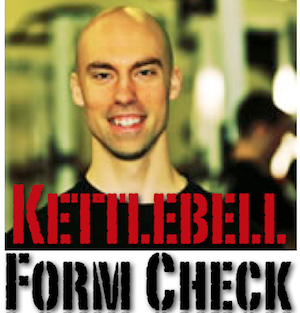
Tony Uses Kettlebells
Background on Tony Gentilcore
First come background is in order. You may be asking, who is Tony Gentilcore and why does it matter. If you’ve been around Cube Dweller Fitness for a while you may recall my articles on the 20 Must Read Fitness Sites of 2012. Tony’s site, aptly named TonyGentilcore.com, made the list. Tony is one of the founders of Cressey Performance and puts out some awesome information on training athletes for performance. Better yet, his content is fun to read – solid advice sprinkled with some attitude, humor, and reality.
Kettlebell Bigotry Exposed
Tony put out a rant responding to rants where people tout kettlebells or death (Well, not quite. But it borders on a religious war for some.) Tony hit it head on and is trying to get people to realize that the kettlebell is one tool. Drop the hate and accept that the kettlebell is just one tool to help people get in shape.
If you’ve been around my site for a while you know that I enjoy kettlebells. But I am open and enjoy other forms of training as well. My main reasons for using kettlebells are:
- Posterior Chain Focus – I sit a lot both at work and home, so I know my hips and entire posterior chain need to get worked. The kettlebell tends to focus more on the training the posterior chain than some other forms of exercise. Not better than other forms of training. Kettlebells don’t train the posterior chain better than dumbbell thrusters, or regular squats. But many of the kettlebell movements do train the posterior chain.
- Small Foot Print – I train at home, in my garage, and whatever equipment I buy needs to find space in my garage. While I’d love to transform the garage into a full-on Olympic lifting gym with power rack and weight stacks that just isn’t going to happen. I need something with a small footprint – kettlebells fit the bill since they can fit along the side of the garage.
Simple as that. Chose your own forms of training, know your reasons behind it, but be willing to accept that there are many ways to lift heavy stuff. I was on the sidelines cheering Tony on with that post. Forget the bigotry and be willing to accept other forms of training.
Kettlebell Training at Cressey Performance
Late last week Tony published another excellent post entitled Cressey Performance In-Service: Get-up/Swing Tutorial. I’ve caught a few of these and enjoy them. To me the In-Service series feels like a glimpse behind the curtain at CP to see how they train athletes to improve their performance. In this one Tony was put on the spot and decided to reveal how he uses the kettlbell in his own training and how they use kettlebells to train their athletes.
The video is long and covers two exercises the Turkish Get Up and the Swing. In the post Tony talks about his background with kettlebells and asks for kettlebell tips. That’s where it hit me; could I, should I, respond to Tony’s request for kettlebell tips?
Tony’s well known in the online community and has several well known kettlebell experts who could respond. Maybe I should just let them – or maybe not. Ugh – in reared the ugly head of FEAR.
But then I read another post from one of my favorite fitness sites, Diesel Strength and Conditioning about I have fear. James Smith (aka Smitty) drops a bomb and describes how FEAR can be debilitating, but instead we can choose to overcome it and keep moving. When I read it I decided that we would respond to Tony’s video with a Kettlebell Form Check.
Kettlebells – Are they the Wonder Fitness Gadget to Solve all Issues?
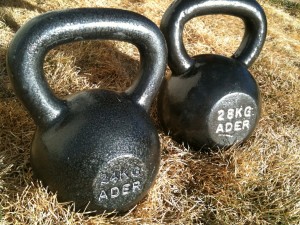 Before we dig into it Tony Gentilcore’s kettlebell swing let’s face the question: Are kettlebells the wonder-fitness gadget to solve all issues?
Before we dig into it Tony Gentilcore’s kettlebell swing let’s face the question: Are kettlebells the wonder-fitness gadget to solve all issues?
Frankly, no.
Are kettlebells effective? – yes.
Is a properly executed Olympic lift effective? – yes.
What about sandbags, are they effective? – yes.
The list could go on and on. There are many creative and effective ways to train.
While I’ll hold off on buying a Shake Weight, or Perfect Push-up – kettlebells are a tool you can use to get in shape. They work, but so do many other forms of training. I will undoubtedly continue to write about kettlebells, but I’m no kettlebell bigot.
Choose a form of training that works and a form of training you enjoy enough to do regularly. Get moving and get in shape. Quit arguing about the superiority of different forms of training, just go lift something heavy.
Kettlebell Form Check of Tony’s Swing
So let’s get to the core of it and dig into Tony’s kettlebell swing with this episode of Kettlebell Form Check. Tony spent time in his tutorial going over two movements with the Kettlebell, the Turkish Get up (TGU) and the Kettlbell Swing. This Kettlebell Form Check is only going to focus on the swing, let us know if we should do another episode on the TGU by leaving a comment below.
Coaching the Kettlebell Swing
When consulting with The Kettlebell Form Check experts, their first response was his form is pretty good.
That’s worth noting. To be clear, we’re not slamming Tony nor Cressey Performance at all. Tony asked for tips and ways to improve, period. Got it?
That said, we’ll look at the kettlebell swing through four Elements of Efficiency: relaxation, breathing, precise movement, and posture. Also, remember that the S.A.I.D. Priniciple is always in play – so we will always get good at what we practice repetativly – Good or Bad.
Relax to Swing
Stress and tension – maybe just us cube dwellers have the corner of the market on stress and tension, but I’m guessing not. Life is full of stress. One reason to workout is to eliminate our stress, so relax.
When coaching the kettlebell swing Tony emphasizes tension. Rather than focusing on building tension, work to build only necessary, or appropriate tension. If our workouts build unneeded tension our bodies respond and sustain it. Now play this out. Let’s say I wake up early, grab the kettlebell, focus on tension through out my body while working out, then head off to work to sit and stress all day. That tension just builds.
According to the good Dr. Higgins this type of unneeded tension can build in our bodies so it responds much like repetitive movement syndrome. He has treated too many injuries from people holding tension when it isn’t needed.
Tense when needed, no more, no less. Focus on relaxing, in position, then swing.
That thought of relaxing should also be applied to the grip. Tony says, gripping the kettlebell tight, like they are trying to melt the kettlebell in their hand.
The doctor shuddered at the thought of that much tension. Instead relax the grip. Loosely cradle the kettlebell. Do not build unneeded tension in the forearms.
The other key to building a loose grip is understanding the progression of different movements with the kettlebell. The kettlebell swing is a foundational movement that builds key patterns for more complex movements. Building a loose and relaxed grip prepares you to get ready to learn and perfect movements like the kettlebell clean and the kettlebell snatch. If you are working to melt the kettlebell into your hands that tension will destroy the skin of your hands when the bell starts to rotate in movements like the clean and snatch.
To perform the kettlebell swing, loosely grip the kettlebell – relax and swing.
Breathing Pattern For the Kettlebell Swing
How and when to breath matters but the subject wasn’t touched in Tony’s session. Since it wasn’t mentioned it is hard to tell exactly how Cressey Performance and Tony coach people to breath while doing the kettlebell swing.
But how you breath matters. Getting oxygen keeps you going, but as we dig into the details of a specific pattern of breathing with the kettlebell swing you’ll see how your breath can help drive the movement. That’s always good when our systems work together.
Check out the Kettlebell Form Check on my own swing: Breath right while doing the kettlebell swing. I was following the traditional-style breath pattern while performing the swing. Exhale on the way up, inhale on the way down — completely backwards.
Use these coaching tips to fix the breathing pattern for the kettlebell swing and let breathing “drive” the movement:
- Exhale at the bottom, grab the kettlebell
- Inhale through your nose as you snap the hips forward. This will fill the chest and help reach full extension and provide more support to the spine.
- Exhale through your mouth as you let the kettlebell swing back down.
Precise Movement While Doing the Kettlebell Swing
Efficient movement means precise movement. This is one topic that is really just a praise for something done well without being addressed. Tony’s got this movement down. But as you work on the swing make sure you are examining your movement so that it is precise.
Consider a scissor lift. The joints move together to efficiently raise, or lower, the platform. Here is a link so you geeks can evaluate the physics: http://www.engineersedge.com/mechanics_machines/scissor-lift.htm – just make the center of rotation the central portion of the shaft of the femur.
Our knees and hips must work in unison. On the Kettlebell Form Check video we slow down Tony’s swing to watch how the knees and hips are working together. Especially on the decent, Tony’s knees and hips begin to bend at the same time, then reach their full range of motion together – synchronicity.
That’s ideal and worth training. Get the motion of the kettlebell swing precise. Again, both joints should be working at the same time: both the hips and the knees should begin bending together and both should reach their full range of motion at the same time.
One benefit of working with a tool like the kettlebell and specifically the kettlebell swing is that it can drill in the mechanics of this movement. Synchronizing the knees and hips is a movement we do all of the time. It applies to performing a squat, or hiking the back country. Efficient movement, means precise movement.
Correct Posture for the Kettlebell Swing
While Tony’s swing was pretty good there are a few key points of posture that are worth pointing out. When coaching starting position and posture Tony suggests a stance just over shoulder width; that’s okay, but …
Instead let’s get a bit more detailed with these steps:
- Place the kettlebell 1.5-2 feet in front of you with the handle going from side-to-side.
- Then stand with your feet parallel and roughly shoulder width apart.
- Bend at the hips and check knee spacing. To make room for the kettlebell aim for three fist widths between your knees. Measure this by making a fist with your thumb out and extended – thumbs up brother. Place each of your fists on the insides of your knees. Your feet should be far enough apart that the tips of your thumbs just reach each other tip-to-tip.
- Bend at the hips to reach towards the kettlebell
- Grasp loosely – think of making OKAY signs around the horn (or handle) of the kettlebell.
- Start to extend your hips – partially. Just extend enough to let the kettlebell swing back.
- Drive your hips forward – this is starts the first swing.
While those two steps may not sound like much, they will position your feet properly so your feet point forward and you have enough room for the kettlebell. Starting with the gentle swing of the kettlebell off the ground kicks off the momentum of the swing.
While there’s nothing wrong with standing up (performing a deadlift) to begin, you can skip the step and gain that initial momentum as you lift the kettlebell off the ground.
Kettlebell Form Check
Kettlebells can help build efficient movement and strength. This episode helps us dig deeper into the kettlebell swing by remembering to relax, breath right, aim for precise movement, and correct posture.
Thanks to Tony for starting such a livley and informative discussion!
Curious on how your kettlebell form stacks up? Submit a video and have the Kettlebell Form Check experts take a look.


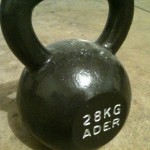
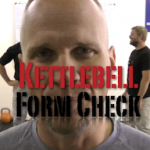

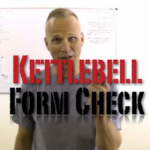
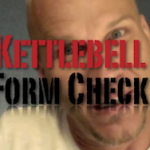
Want to discuss? Join the conversation CubeDwellerFitness's Facebook Page.